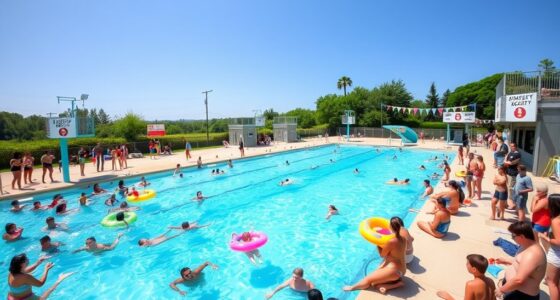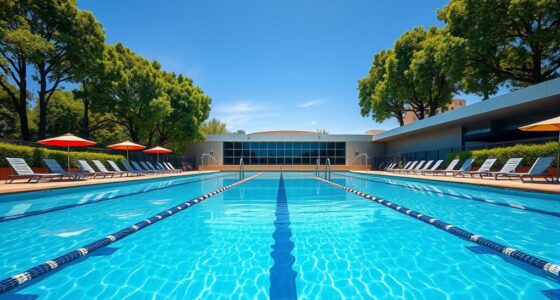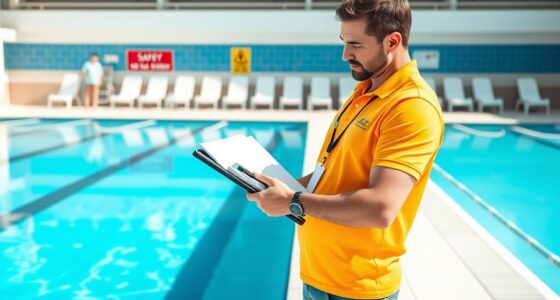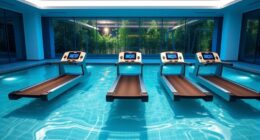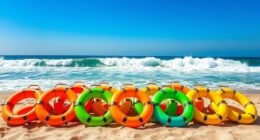When designing a waterpark, you must guarantee safety and fun go hand in hand. Clearly mark depth zones, install sturdy guardrails, and keep slides slip-resistant. Regular maintenance, staff training, and emergency protocols are essential. Balance attraction placement to prevent congestion and optimize flow. Incorporate safety signage, fencing, and accessible rescue equipment. These measures build trust and excitement for your guests—continue exploring to discover how to create a safe, enjoyable waterpark experience.
Key Takeaways
- Implement clearly marked, appropriate depth zones and regular equipment maintenance to ensure wave pool safety.
- Incorporate safety features like guardrails, slip-resistant surfaces, and signage on all water attractions.
- Ensure slide height and safety regulations are followed through collaboration with safety experts and regular reviews.
- Design park layouts to optimize flow, prevent congestion, and facilitate emergency access with strategic placement of rides and pathways.
- Provide comprehensive staff training, safety drills, and emergency equipment to enhance response readiness and guest safety.
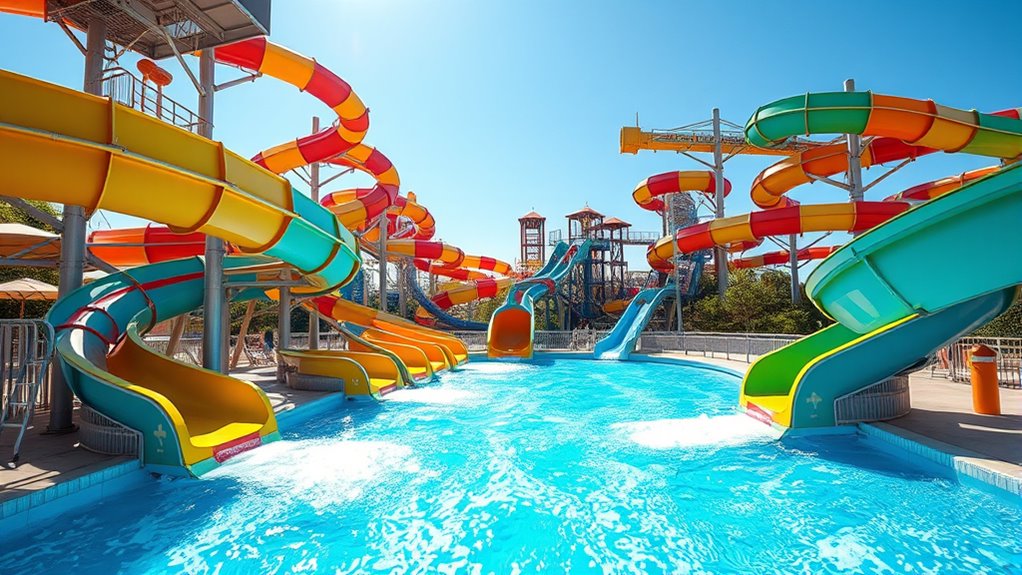
Designing a waterpark requires careful planning to guarantee safety, functionality, and fun. One of the most exciting features you’ll include is the wave pool, which draws crowds eager to experience the ocean’s thrill. However, guaranteeing wave pool safety is critical. You need to design the pool with appropriate depth zones, clearly marked and enforced, to prevent accidents. Regular maintenance of the wave generation equipment is essential to avoid malfunctions that could cause injuries. You should also install safety signage and emergency protocols, such as lifeguard stations and rescue equipment, to quickly respond to any issues. Educating visitors about safe behavior in the wave pool can prevent injuries, especially for children and inexperienced swimmers. Incorporating proper safety features**** can further enhance the overall security of your waterpark environment.
Ensure wave pool safety with proper design, clear signage, regular maintenance, and trained staff for a fun and secure waterpark experience.
Another key aspect is adhering to slide height regulations. These rules are put in place to protect your guests, especially children and thrill-seekers, by setting safe height limits for different types of slides. When planning your slide structures, you’ll want to work closely with engineers and safety experts to guarantee all slides meet local codes and industry standards. Properly designed slides include features like guardrails, non-slip surfaces, and smooth transitions to minimize the risk of falls or injuries. You should also provide clear signage indicating height restrictions and safety instructions to help guests make informed decisions. Oversized slides might be thrilling, but if they don’t comply with regulations, they pose serious safety hazards.
It’s crucial to contemplate the flow of the waterpark’s layout to prevent congestion and accidents. For instance, the placement of slides should allow for smooth queuing and easy access to exit points, avoiding bottlenecks that could lead to collisions or injuries. You also need to think about the materials used in slide construction; slip-resistant surfaces and sturdy, corrosion-resistant materials contribute to long-term safety and durability.
Staff training is equally important. Your lifeguards and attendants should be thoroughly trained in emergency procedures, including how to handle accidents in the wave pool or on slides. Regular safety drills help keep everyone prepared. Incorporate safety features like barriers, fencing, and secure walkways to limit access to certain areas when necessary. By prioritizing these safety considerations—wave pool safety protocols, adherence to slide height regulations, and proper layout design—you create a secure environment that allows your guests to enjoy the waterpark’s thrills without unnecessary risks. Ultimately, investing in safety measures not only protects visitors but also builds trust, encouraging repeat visits and positive word-of-mouth for your waterpark.
Frequently Asked Questions
How Do Waterparks Accommodate Guests With Disabilities?
You can guarantee guests with disabilities feel welcome by incorporating accessible features and inclusive design throughout your waterpark. Install ramps, wider pathways, and accessible restrooms to accommodate everyone. Use adaptive water play equipment and provide clear signage. By prioritizing these features, you create an inclusive environment where all guests can enjoy the fun and safety of your waterpark comfortably and confidently.
What Are the Environmental Impacts of Waterpark Construction?
You should consider the environmental impacts of waterpark construction by choosing eco-friendly materials that reduce pollution and resource consumption. Implementing sustainable practices helps protect local wildlife and promotes wildlife conservation. Additionally, designing your waterpark with energy-efficient systems and water-saving technologies minimizes ecological footprint, ensuring the project benefits the environment while providing fun and safety for guests. Being mindful of these factors demonstrates your commitment to sustainability and conservation efforts.
How Is Water Quality Maintained and Monitored?
You maintain water quality by implementing water treatment systems that regularly filter and disinfect the water. You also perform chemical monitoring to guarantee pH levels, chlorine, and other disinfectants stay within safe ranges. This ongoing process involves testing water samples frequently, adjusting chemicals as needed, and using automated systems for real-time monitoring. These steps help keep the water safe, clean, and fun for all visitors.
What Are the Latest Safety Technology Innovations?
You can enhance safety with the latest innovations like virtual reality simulations that train staff in emergency response, and augmented safety features that provide real-time hazard alerts. These technologies help you proactively identify risks and respond quickly. By integrating VR and AR into your safety protocols, you create a more secure environment for guests, ensuring fun doesn’t come at the expense of safety. Stay ahead with these cutting-edge safety tools.
How Do Waterparks Handle Emergency Evacuations?
You should familiarize yourself with the waterpark’s emergency protocols and evacuation procedures before visiting. Staff are trained to guide guests quickly and calmly, using clear signals and designated exits. In an emergency, follow posted signs, listen to staff instructions, and move swiftly to the nearest safe exit. Staying aware of these procedures helps guarantee your safety and that others around you during evacuations.
Conclusion
By prioritizing safety and fun in your waterpark design, you create an experience that’s truly unforgettable—like stepping into a paradise where excitement and security go hand in hand. Every detail, from thrill rides to shallow pools, should work seamlessly to keep guests safe while maximizing enjoyment. Remember, a well-designed waterpark isn’t just a place to splash around; it’s a kingdom of joy where every moment feels as epic as a hero’s quest.


